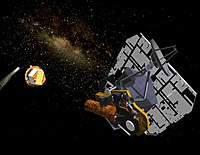
Photo from wikipedia
Abstract Hail impact testing can be requisite to comply with state, federal, and international standards. In these testing procedures, impact velocities are a critical measurement used to calculate the hail… Click to show full abstract
Abstract Hail impact testing can be requisite to comply with state, federal, and international standards. In these testing procedures, impact velocities are a critical measurement used to calculate the hail projectile’s resulting kinetic energy. It often is an implicit assumption in many of these hail impact tests that the missile velocity, as measured at the chronograph, is the velocity at the point of impact. Experimental results presented in this paper establish that a significant decrease in missile velocity can occur between chronograph and test specimen caused by air resistance acting upon the projectile. The actual velocity and kinetic energy at impact upon the test specimen may be significantly lower than assumed. The experimental data lead to the development of an equation that estimates the required velocity at the measuring position to produce the desired impact velocity as a function of the ice sphere diameter and the distance to the impact position.
Journal Title: Journal of Wind Engineering and Industrial Aerodynamics
Year Published: 2021
Link to full text (if available)
Share on Social Media: Sign Up to like & get
recommendations!